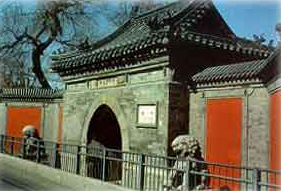 The Temple of Wisdom Attained, situated in the Chaoyangmen area of Beijing, was built by order of Wang Zhen, the chief eunuch at the court of Emperor Zhengtong (reigned 1436-1449 and 1457-1464) of the Ming Dynasty. Wang Zhen was the first eunuch in the history of the MING dynasty to make conspicuous use of his power for personal ends.
The Temple of Wisdom Attained, situated in the Chaoyangmen area of Beijing, was built by order of Wang Zhen, the chief eunuch at the court of Emperor Zhengtong (reigned 1436-1449 and 1457-1464) of the Ming Dynasty. Wang Zhen was the first eunuch in the history of the MING dynasty to make conspicuous use of his power for personal ends.
The temple is one of the largest and finest examples of Buddhist architecture from the period. Beginning from the front gate and extending to the Hall of Ten Thousand Buddhas (Wanfoge), seven principal halls are comprised in the temple complex. The layout plan known as ?the Seven Monastery Buildings.? A notable feature of the temple is the glazed tiles which line the roof ridges of the major buildings, augmenting the solemnity of the complex.
The Hall of Ten Thousand Buddhas is dedicated to the worship of the Tathagata Buddha (Rulaifo), and is also called the Hall of Tathagata Budha. The 9,000 niches in the walls of the hall each house a small statue of the Buddha. The ceiling panels and lattice windows with their gilding and multicolored decoration are exquisite examples of temple art. The particularly fine octagonal cupola was removed from the temple in the 1930s and is now in the Nelson Museum in Kansas, USA.
The temple contains a fine octagonal ?Revolving Scripture Cabinet? (Zhuanlunzang), which is constructed of wood and rests on a marble base. Its relief decorations of birds, goddesses, deities, human figures, lions, and flowers reveal craftsmanship of a very high level.
Although the temple was repaired and rebuilt many times during the Ming and Qing dynasties, the crossbeams and corner brackets in the main halls date back to the 15th century. The scripture cabinets, Buddhist images and decorative carvings preserved in the temple are all in the Ming Dynasty style, rendering the temple one of the best examples of the Ming architecture in Beijing.
Address: No.5 Lumicang, Dongcheng District.
Add: Bus 44; Subway
(china.org.cn April 25, 2003)
|

